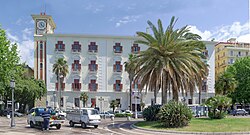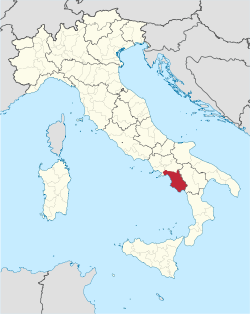Province of Salerno | |
|---|---|
 Palazzo Sant'Agostino, the provincial seat | |
 Map highlighting the location of the province of Salerno in Italy | |
| Coordinates: 40°41′N14°46′E / 40.683°N 14.767°E | |
| Country | |
| Region | Campania |
| Capital(s) | Salerno |
| Comuni | 158 |
| Government | |
| • President | Vincenzo Napoli (Partito Democratico) |
| Area | |
• Total | 4,923 km2 (1,901 sq mi) |
| Population (2025) [1] | |
• Total | 1,054,766 |
| • Density | 214.3/km2 (554.9/sq mi) |
| GDP | |
| • Total | €19.358 billion (2015) |
| • Per capita | €17,479 (2015) |
| Time zone | UTC+1 (CET) |
| • Summer (DST) | UTC+2 (CEST) |
| Postal code | 84100 |
| Telephone prefix | 089 |
| ISO 3166 code | IT-SA |
| Vehicle registration | SA |
| ISTAT | 065 |
| Website | www.provincia.salerno.it |
The province of Salerno (Italian : provincia di Salerno) is a province in the Campania region of Italy. It has 1,054,766 inhabitants as of 2025. [1]


